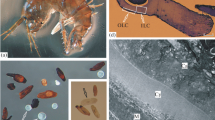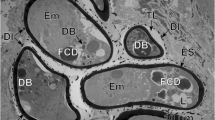Abstract
The eggshells of young developmental stages in the uterus are rather thin and homogenous. In the brezel stage of Brugia malayi they are 35 nm thick and 20 nm in Litomosoides carinii. In young developmental stages up to brezel stages the eggshells bind the lectins WGA, DBA and PNA labelled with colloidal gold. This shows that GlcNAc, GalNAc and Gal residues are present at the surface of the sheath. In intrauterine microfilariae of B. malayi the original sheath is reduced to a thickness of 7 nm. It is reinforced by secretions from a specialized area of the epithelium of the uterus which do not appear as a homogeneous layer but look like a string of pearls. This layer may be called the “uterine layer”. It has a thickness of 40–80 nm. In the microfilaria of L. carinii, the thickness of the original sheath is reduced to 2–3 nm and the uterine layer has a thickness of 7 nm. The uterine layer does not react with any of the lectins, which shows that the surface lacks N-acetylglucosamine, N-acetylgalactosamine and galactose residues. The uterine layer appears to be an ancestral (plesiomorphic) feature which is present in free-living nematodes and the highly specialized bloodforms of filariae. The uterine layer seems to protect and disguise the original sheath against the immune reactions of the host.
Similar content being viewed by others
References
Anya AO (1976) Physiological aspects of reproduction in nematodes. Adv Parasitol 14:267–350
Chandrashekar R, Rao UR, Rajasekariah GR, Subrahmanyam D (1984) A method for the purification of microfilariae free of blood cells. J Helminthol 58:69–70
Cherian PV, Stomberg BE, Weiner DJ, Soulsby EJ (1980) Fine structure and cytochemical evidence for the presence of a polysaccharide surface coat of Dirofilaria immitis microfilariae. Int J Parasitol 10:227–233
Devaney E (1985) Lectin-binding characteristics of Brugia pahangi microfilariae. Trop Med Parasitol 36:25–28
Ellis DS, Rogers R, Bianco AE, Denham DA (1978) Intrauterine development of Dipetalonema viteae. J Helminthol 52:7–10
Fuhrman JA, Piessens WF (1985) Chitin synthesis and sheath morphogenesis in Brugia malayi microfilariae. Mol Biochem Parasitol 17:93–104
Furman A, Ash LR (1983a) Analysis of Brugia pahangi microfilariae surface carbohydrates: comparison of the binding of a panel of fluorescinated lectins to mature in vivo-derived and immature in utero-derived microfilariae. Acta Trop (Basel) 40:5–51
Furman A, Ash LR (1983b) Characterization of the exposed carbohydrates on the sheath surface of in vitro-derived Brugia pahangi microfilariae by analysis of lectin binding. J Parasitol 69:1043–1047
Geoghegan WD, Ackerman GA (1977) Adsorption of horseradish peroxidase, ovomucoid and anti-immunoglobulin to colloid gold for the indirect detection of Concanavalin A, wheat germ agglutinin and goat antihuman immunoglobulin G on cell surfaces at the electron microscopic level: a new method, theory and application. J Histochem Cytochem 25:1187–1200
Geyer E, Zahner H (1987) Occurrence of albumine and immunoglobulins on the sheath of blood microfilariae of Litomosoides carinii Trop Med Parasitol 38:66
Goodman SL, Hodges GM, Trejdosiewicz LK, Livingston DC (1981) Colloidal gold markers and probes for routine application in microscopy. J Microsc 123:201–213
Hockley DJ, Worms MJ, Esden LM (1968) Electron micrographs of microfilariae. Trans R Soc Trop Med Hyg 62:468–469
Horisberger M (1979) Evaluation of colloidal gold as a cytochemical marker for transmission and scanning electron microscopy. Biol Cell 36:253–258
Horisberger M, Rosset J (1977) Colloidal gold, a useful marker for transmission and scanning electron microscopy. J Histochem Cytochem 25:295–305
Kaushal NA, Simpson AJG, Hussain R, Ottensen EA (1984) Brugia malayi: stage-specific expression of carbohydrates containing N-acetyl-D-glucosamine on the sheathed surfaces of microfilariae. Exp Parasitol 58:182–187
Kiefer E, Rudin W, Betschart B, Weiss N, Hecker H (1986) Demonstration of anticuticular antibodies by immuno-electron microscopy in sera of mice immunized with cuticular extracts and isolated cuticles of adult Dipetalonema viteae. Acta Trop (Basel) 43:99–112
Lämmler G, Saupe E, Herzog H (1968) Infektionsversuche mit der Baumwollrattenfilarie Litomosoides carinii bei Mastomys natalensis (Smith, 1934). Z Parasitenkd 32:281–290
Laurence BR, Simpson MG (1974) The ultrastructure of Brugia, Nematoda: Filaroidea. Int J Parasitol 4:523–536
McLaren DJ (1972) Ultrastructural studies on microfilariae (Nematoda: Filaroidea). Parasitology 65:317–332
Parkhouse RME, Ortega-Pierres G (1984) Stage-specific antigens of Trichinella spiralis. Parasitology 88:623–630
Peters W, Kolb H, Kolb-Bachofen V (1983) Evidence for a sugar receptor (lectin) in the peritrophic membrane of the blowfly larva, Calliphora erythrocephala Mg. (Diptera). J Insect Physiol 29:275–280
Philipp M, Worms MJ, McLaren DJ, Ogilvie BM, Parkhouse RM, Taylor PM (1984) Surface protein of a filarial nematode: a major soluble antigen and a host component on the cuticle of Litomosoides carinii. Parasite Immunol 6:63–82
Rao UR, Chandrashekar R, Subrahmanyam D (1987) Litomosoides carinii: characterization of surface carbohydrates of microfilariae and infective larvae. Trop Med Parasitol 38:15–18
Rogers R, Ellis DS, Denham DA (1976) Studies with Brugia pahangi: 14. Intrauterine development of the microfilariae and a comparison with other filarial species. J Helminthol 50:251–257
Sänger J, Lämmler G, Kimmig P (1981) Filarial infections of Mastomys natalensis and their relevance for experimental chemotherapy. Acta Trop Basel 38:277–288
Sayers G, Mackenzie CD, Denham DA (1984) Biochemical surface components of Brugia pahangi microfilariae Parasitology 89:425–434
Schraermeyer U, Peters W, Zahner H (1987) Lectin binding studies on adult filariae, intrauterine developing stages and microfilariae of Brugia malayi and Litomosoides carinii. Parasitol Res 73:550–556
Schuster J, Lämmler G, Rudolph R, Zahner H (1973) Pathophysiologische Aspekte bei der Schistosoma mansoni — Infektion der Mastomys natalensis unter Chemotherapie mit Hycanthone. Z Tropenmed Parasitol 24:487–499
Simpson MG, Laurence BR (1972) Histochemical studies on microfilariae. Parasitology 64:61–88
Tongu Y (1974) Ultrastructural studies on the microfilariae of Brugia malayi. Acta Med Okayama 28:219–242
Wharton D (1980) Nematode egg-shells. Parasitology 81:447–463
Zaman V (1987) Ultrastructure of Brugia malayi egg shell and its comparison with microfilarial sheath. Parasitol Res 73:281–283
Author information
Authors and Affiliations
Additional information
Supported by the WHO Onchocerciasis Chemotherapy Project (OCT)
Rights and permissions
About this article
Cite this article
Schraermeyer, U., Peters, W. & Zahner, H. Formation by the uterus of a peripheral layer of the sheath in microfilariae of Litomosoides carinii and Brugia malayi . Parasitol Res 73, 557–564 (1987). https://doi.org/10.1007/BF00535333
Accepted:
Issue Date:
DOI: https://doi.org/10.1007/BF00535333




